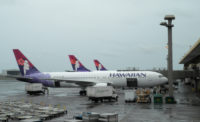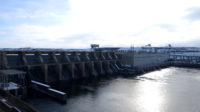A report last month to the Hawaii legislature on a dam collapse that killed seven people is prompting quick action to repair damage and bolster the state's dam-inspection program. Identical bills are making their way through the legislature's house and senate to appropriate $2 million for cost recovery, stabilization of slopes and drainage, inspections and costs for criminal and civil actions related to the collapse.
 U.S. Geological Survey |
The sudden failure of Ka Loko Dam just before dawn March 14, 2006, on Kauai, Hawaii's northernmost large island, released 1.6 million tons of water. A 70-ft-high, 200-ft-wide wave crashed through the Moala forest, snapping trees, demolishing a cluster of houses and killing seven people.
The collapse of the privately owned earthen dam, located at the headwaters of Kailapa Stream, left a 250-ft-wide gap in the dam's center toward the right abutment, and prompted Robert Bunda (D), at the time the president of the state senate, to call for an investigation.
The Ka Loko Dam was constructed in 1890 to irrigate a sugar plantation. It was inspected by the plantation owner, but never apparently by the Territory or the State of Hawaii as required by a 1987 state law. It was raised 12 ft in 1912 to its modern height of 43 ft by sluicing, a method used to construct hydraulic fill dams. The reservoir's capacity was more than 400 million gallons.
|
State authorities and the Environmental Protection Agency received a handful of complaints about water releases by the dam in the month before the breach. But the cause of the collapse remains uncertain, even to the investigators. "Forty-two days of straight rain may have caused water overflows and erosion," says Lelio Mejia, principal engineer and vice president at the Oakland office of San Francisco-based URS Corp., one of the investigators. "I also noticed two important possibilities for the failure: the condition of the spillway, which was filled with local soils and virtually gone, and the lack of maintenance that allowed vegetation to overgrow."
But Bill McCorriston, attorney for dam owner James Pflueger, told The Honolulu Advertiser, "We continue to be firm in our belief that the spillway had nothing to do with the failure." The estimate for repairing the dam is $1.9 million, but no plans to repair it have been announced.
The report recommends that Hawaii's Dam Safety Program should have 6.5 full-time employees, up from 1.5 positions currently. Increased funding would support inspecting the state's other 129-plus dams.
 Related Links:
Related Links: 



Post a comment to this article
Report Abusive Comment